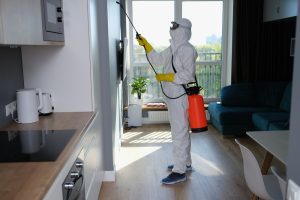Woodworm Treatments
You are likely familiar with ant / termite infestations and the extensive integral damage that they can cause if neglected for a prolonged period. But there is another type of parasite that isn’t as well known – the woodworm.
Related Topics (Sponsored Ads):
Interior Ad Block Content
Interior Ad Block Content
Interior Ad Block Content
Interior Ad Block Content
Woodworm infestations can significantly compromise the structural integrity and aesthetic appeal of wooden items and structures. It is caused by the larvae of wood-boring beetles, which tunnel through the wood, leaving behind a network of tunnels and exit holes. Luckily, in order to effectively address woodworm problems, there are a range of treatments and preventative measures available. So, if you spot suspicious holes, degradation or weakness in wood, be sure to act on it right away.
With that being said, it’s time to say goodbye to woodworm infestations. In this article, we will explore the top five woodworm treatments, their suitability, advantages, as well as provide helpful hints on how to spot a woodworm problem and tips on how to avoid it.

Boron Treatments
Boron-based woodworm treatments are effective solutions for preventing and treating woodworm infestations. Boron compounds penetrate the wood and are toxic to wood-boring insects, effectively killing larvae and preventing further infestations. This is an effective solution for both preventing and treating woodworm in various wooden structures, including furniture, flooring, and structural timber.
Advantages: Boron treatments are relatively non-toxic to humans and pets, making them a safe option for indoor use. They also provide long-lasting protection against wood-boring insects and can be applied as a spray, gel, or injected directly into the wood.
Fumigation
Fumigation involves the use of chemicals in gaseous form to eradicate wood-boring insects. The fumigant penetrates the wood, killing larvae and adult beetles. Overall, fumigation is suitable for severe woodworm infestations in large, enclosed spaces such as barns, warehouses, or timber storage facilities.
Advantages: This treatment option is powerful and highly effective in eliminating all life stages of wood-boring insects, and can reach inaccessible areas within the wood. It is a potent treatment for severe infestations and is commonly used in commercial settings.
Heat Treatment
Heat treatment involves exposing infested wood to high temperatures to kill wood-boring insects. This method is often used in specialized chambers or with portable heat treatment equipment. If you have woodworm-infested furniture, wooden artifacts or smaller wooden items, then this would make a great choice.
Advantages: Firstly, heat treatment is chemical-free, making it an environmentally friendly option. It effectively kills all life stages of wood-boring insects, including eggs, larvae, and adult beetles. Additionally, it preserves the integrity of the treated wood and is safe for use on antiques and delicate wooden items.
Insecticidal Sprays and Preservatives
Insecticidal sprays and preservatives contain chemicals that are toxic to wood-boring insects. These products are applied to the surface of the wood to kill larvae and deter future infestations. for treating and protecting wooden furniture, doors, and other exposed wooden surfaces.
Advantages: The greatest advantage of these types of treatments is that they are easy to apply and provide a protective barrier against wood-boring insects. They are also particularly useful for ongoing maintenance and protection of wooden items in residential and commercial settings.
Professional Pest Control Services
Professional pest control services offer comprehensive woodworm treatments, including inspection, identification of infested areas, and tailored treatment plans using a combination of methods. Professional pest control services are ideal for severe or widespread woodworm infestations in residential, commercial, and industrial settings.
Advantages: Ultimately, these professional pest services provide expertise in identifying and treating woodworm infestations effectively. They offer a combination of treatment methods tailored to the specific infestation, ensuring thorough eradication and long-term protection of wooden structures.
Tips to Spot a Woodworm Problem
To successfully identify a woodworm infestation, it’s important to be vigilant and look for the following signs:
Exit Holes: Look for small, round exit holes in wooden items or structures. These holes are evidence of adult wood-boring beetles emerging from the wood.
Frass: Frass, which is a powdery substance resembling fine sawdust, may be present around exit holes or on the surface of the wood. This is the excrement of wood-boring larvae.
Weak or Damaged Wood: Wood affected by woodworm infestations may appear weakened, with visible tunnels or galleries created by the larvae.
Tips to Avoid Woodworm Infestations
Preventative measures can help minimize the risk of woodworm infestations:
Moisture Control: Wood-boring beetles are attracted to damp or moist wood. Therefore, it’s highly recommended to ensure proper ventilation and address any sources of excess moisture to deter wood-boring insects from laying eggs in wood.
Regular Inspections: Periodically inspect wooden items and structures for signs of woodworm activity, especially in areas prone to dampness or high humidity.
Protective Treatments: Applying boron-based treatments or insecticidal sprays to wooden items can provide a protective barrier against wood-boring insects, deterring infestations.
Final Thoughts
As you are now aware, woodworm infestations are no trivial matter, as they are detrimental to both wooden items and structures. However, with the availability of various effective treatments and vigilant preventative measures, these issues can be prevented and addressed.
By promptly identifying woodworm problems and implementing proactive measures to prevent infestations, homeowners and businesses can safeguard their wooden assets from the damaging effects of wood-boring insects.
And of course, always handle and use any kind of pesticide treatment with care. Follow instructions and use gloves and a mask as a safeguard. If you need a professional exterminator, make sure that they are duly licensed and experienced.
Related Topics (Sponsored Ads):
Interior Ad Block Content
Interior Ad Block Content
Interior Ad Block Content
Interior Ad Block Content





